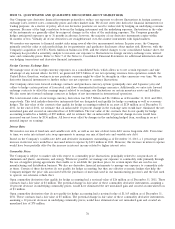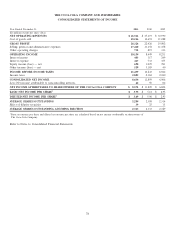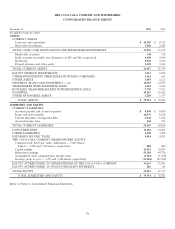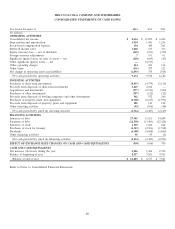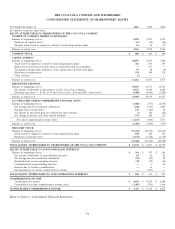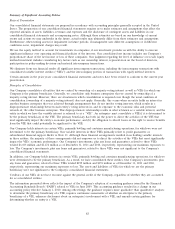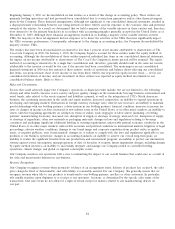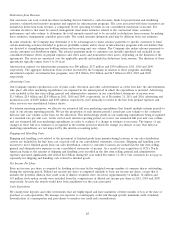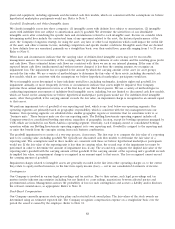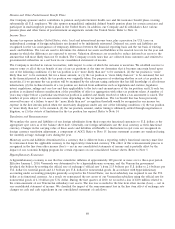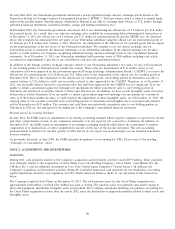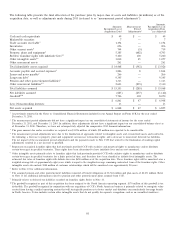Coca Cola 2011 Annual Report Download - page 88
Download and view the complete annual report
Please find page 88 of the 2011 Coca Cola annual report below. You can navigate through the pages in the report by either clicking on the pages listed below, or by using the keyword search tool below to find specific information within the annual report.Short-Term Investments
We classify time deposits and other investments that have maturities of greater than three months but less than one year as
short-term investments.
Investments in Equity and Debt Securities
We use the equity method to account for our investments in equity securities if our investment gives us the ability to exercise
significant influence over operating and financial policies of the investee. We include our proportionate share of earnings and/or
losses of our equity method investees in equity income (loss) — net in our consolidated statements of income. The carrying value
of our equity investments is reported in equity method investments in our consolidated balance sheets. Refer to Note 6.
We account for investments in companies that we do not control or account for under the equity method either at fair value or
under the cost method, as applicable. Investments in equity securities are carried at fair value if the fair value of the security is
readily determinable. Equity investments carried at fair value are classified as either trading or available-for-sale securities with
their cost basis determined by the specific identification method. Realized and unrealized gains and losses on trading securities
and realized gains and losses on available-for-sale securities are included in other income (loss) — net in our consolidated
statements of income. Unrealized gains and losses, net of deferred taxes, on available-for-sale securities are included in our
consolidated balance sheets as a component of accumulated other comprehensive income (loss) (‘‘AOCI’’). Trading securities are
reported as either marketable securities or other assets in our consolidated balance sheets. Securities classified as available-for-sale
are reported as either marketable securities, other investments or other assets in our consolidated balance sheets, depending on
the length of time we intend to hold the investment. Refer to Note 3.
Investments in equity securities that we do not control or account for under the equity method and do not have readily
determinable fair values are accounted for under the cost method. Cost method investments are originally recorded at cost, and
we record dividend income when applicable dividends are declared. Cost method investments are reported as other investments in
our consolidated balance sheets, and dividend income from cost method investments is reported in the line item other income
(loss) — net in our consolidated statements of income.
Our investments in debt securities are carried at either amortized cost or fair value. Investments in debt securities that the
Company has the positive intent and ability to hold to maturity are carried at amortized cost and classified as held-to-maturity.
Investments in debt securities that are not classified as held-to-maturity are carried at fair value and classified as either trading or
available-for-sale.
Each reporting period we review all of our investments in equity and debt securities, except for those classified as trading, to
determine whether a significant event or change in circumstances has occurred that may have an adverse effect on the fair value
of each investment. When such events or changes occur, we evaluate the fair value compared to our cost basis in the investment.
We also perform this evaluation every reporting period for each investment for which our cost basis exceeded the fair value in the
prior period. The fair values of most of our investments in publicly traded companies are often readily available based on quoted
market prices. For investments in nonpublicly traded companies, management’s assessment of fair value is based on valuation
methodologies including discounted cash flows, estimates of sales proceeds and appraisals, as appropriate. We consider the
assumptions that we believe hypothetical marketplace participants would use in evaluating estimated future cash flows when
employing the discounted cash flow or estimates of sales proceeds valuation methodologies.
In the event the fair value of an investment declines below our cost basis, management determines if the decline in fair value is
other than temporary. If management determines the decline is other than temporary, an impairment charge is recorded.
Management’s assessment as to the nature of a decline in fair value is based on, among other things, the length of time and the
extent to which the market value has been less than our cost basis, the financial condition and near-term prospects of the issuer,
and our intent and ability to retain the investment for a period of time sufficient to allow for any anticipated recovery in market
value.
86


